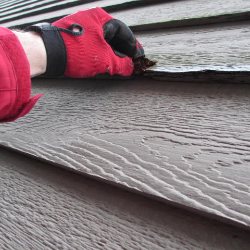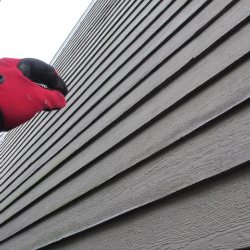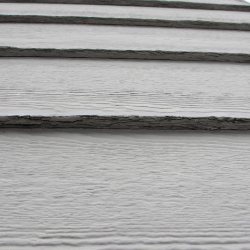Every time I think this is the last failed LP siding job I will inspect, I get proved wrong. Yes, there is still a lot of LP siding out there. Just a Little history of Composite Siding:
The most commonly seen problematic siding out there, hands down, is Louisiana Pacific Inner Seal Siding.
After forming from a Georgia Pacific spin-off in 1972, Louisiana Pacific was born. Building through acquisitions, the company bought Fiberboard Corporation and fifteen southern California building centers that provided the needed distribution points. For long-term success however, the company needed to compensate for the death of the Southern Pine and Douglas Fir and, in general, the market for solid wood lumber production. In the late 1970’s, the company began manufacturing oriented strand board (OSB) by slicing logs into wafers mixed with resin and pressed into panels or sheets. First introduced as Wafer-Wood and later renamed as Inner Seal, the product revolutionized the lumber industry by offering a less expensive and stronger alternative to plywood sheathing. LP advertised the product as “the smart man's plywood.”
Success of the product led to the manufacturing of many engineered wood products including the simulated cedar Inner-Seal siding.
Manufactured from early 1990 through 1996, LP was a defendant in a major class action suit http://www.sidingsolutions.com/pages/classtat.htm and paid claims for the product discoloring, disintegrating, and even growing fungi. Two years after the suit and after LP settled all related suits, the product was re-engineered and is now marketed as LP SmartSide http://www.lpcorp.com/smartside/lap/resources/. Since 1997 the company has sold approximately three billion square feet with no warranty claims.
So there you have the basic history. Now you’re thinking, “So that’s water under the bridge.” Right? Not so fast. A lot of the Inner Seal siding is still on houses in 2012. I’ve done a few inspections recently where the houses had LP siding. The siding had typical swelling at the edges and was clearly delaminating. My opinion is and always has been, that swelled, recalled, moisture-compromised LP siding should be replaced. Regardless of the maintenance, nearly all LP siding installations I look at from this era have failed, at least certainly to some degree.
It is important to understand that once the product fails and swells you cannot reverse the deterioration, by painting for instance. In fact, painting can seal moisture in and accelerate the process. So what should you do? My opinion is be prepared to replace. Get estimates so the expense is anticipated and you’re not surprised at the high cost of siding replacement. Typically this costs between seven and twenty dollars per foot depending on what you’re replacing the siding with. The process is quite involved and includes demo of the existing siding and usually destroying the tarpaper or vapor barrier. The trim may need to be removed and replaced depending on the configuration. Then a new barrier installed followed by new siding and trim. Finally, finished with priming, prep, and painting. So, yes, it’s pretty involved.
Bottom line, if you’re buying a house from the late eighties or early nineties, take a close look at the edge of the siding at the bottom layers. If it’s the failing LP, you will usually see swelling and/or delaminating. Measure the thickness and compare the measurement to siding that is weather protected, for instance under an eave or in a porch. The siding should measure approximately one-half inch. I have seen measurements at lower courses that exceed one inch.
It is really very easy to identify the problematic LP siding; and knowing this ahead of time is useful information prior to making your offer.
As far as the SmartSide (the new LP) siding goes, I encourage you to read the disclaimers on the warranty information LPZB0523-SmartSideWarranty-1.pdf It looks like they went a long way to protect themselves to me.
The following photos are from a past inspection.


